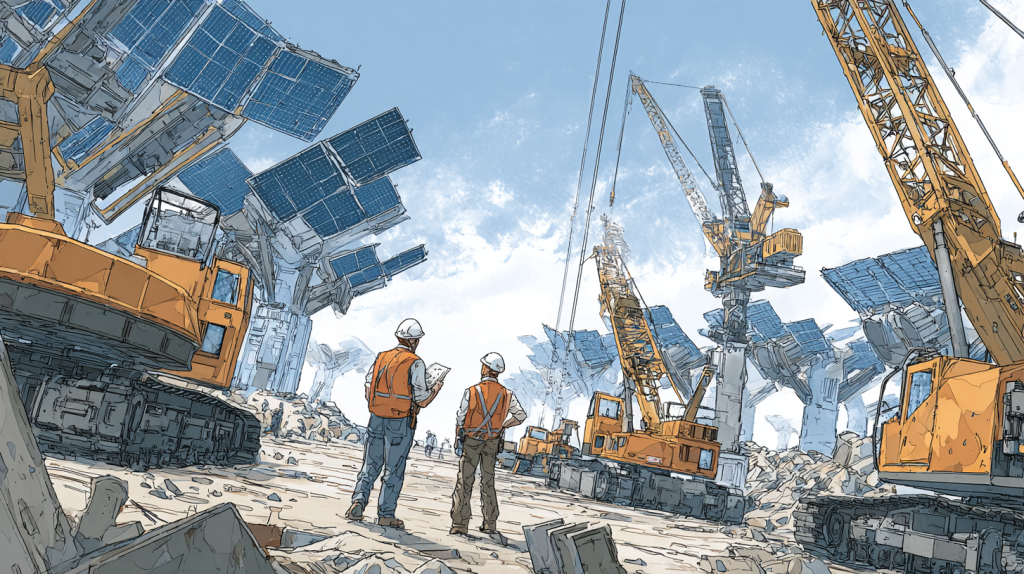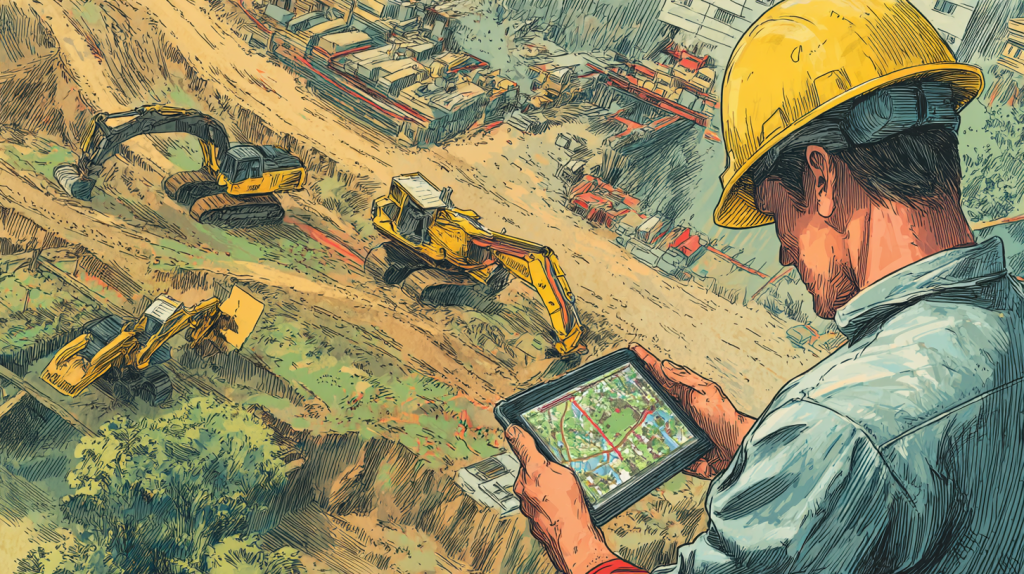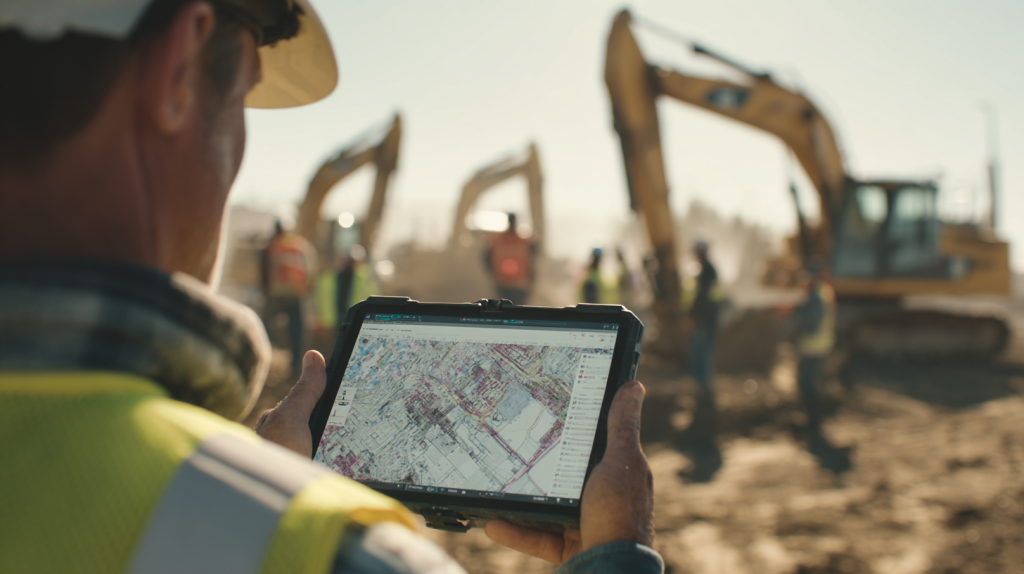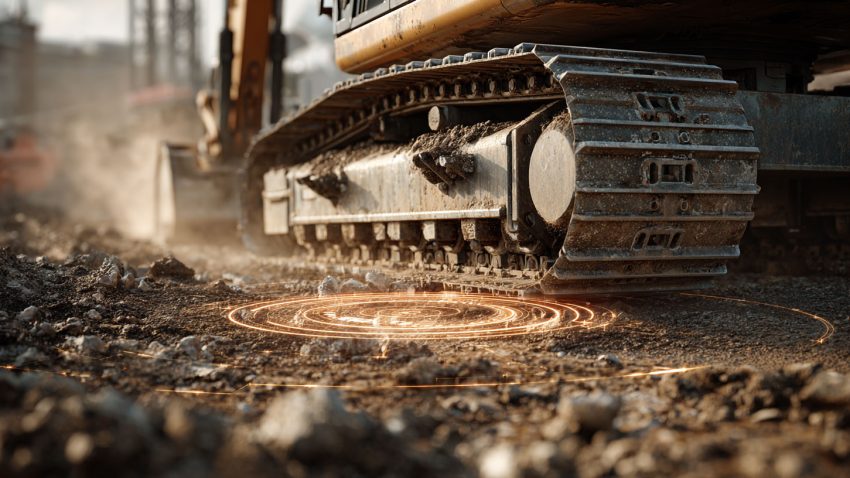What Is a Site Utilization Plan in Construction and Why Does It Matter for Safety and Productivity?
Table of Contents:

A Site Utilization Plan (SUP) is one of the most important tools in modern construction management. It serves as a visual map that shows how every inch of a jobsite will be used—from crane paths and laydown areas to pedestrian walkways, storage zones, and delivery routes. The purpose of the SUP is simple but vital: to keep the site organized, safe, and productive throughout every phase of construction.
A well-planned SUP helps superintendents, project managers, and field teams coordinate space usage and equipment movement. It reduces wasted time caused by material congestion, unsafe crossings, or unclear access points. More importantly, it sets clear expectations for everyone onsite, preventing the costly and dangerous confusion that often occurs on unplanned jobsites.
Beyond logistics, the SUP is also a safety strategy. By identifying risks such as overlapping crane swing zones or congested traffic routes before work begins, it allows teams to plan mitigations proactively. The result is smoother workflow, fewer delays, and better crew performance.
In this article, we’ll break down what a Site Utilization Plan includes, why it’s essential for both safety and productivity, and how modern tools like StruxHub and GIS mapping are transforming how these plans are created and managed. Whether you’re a general contractor, superintendent, or trade partner, understanding how to use a SUP effectively can dramatically improve jobsite performance and reduce risk.
Why Construction Projects Depend on a Site Utilization Plan
Every construction project operates under two constant pressures: maintaining safety and keeping crews productive. A Site Utilization Plan helps balance both by providing a structured, visual layout that prevents confusion and chaos onsite.
Without a SUP, workers, materials, and equipment often overlap in the same areas, creating traffic bottlenecks and safety hazards. Cranes may block access routes, deliveries might interfere with other trades, and valuable time is wasted navigating disorganized spaces. By contrast, a SUP ensures every element of the site—from access roads to equipment zones—is preplanned for optimal workflow.
Owners and contractors benefit equally. Owners gain confidence knowing the jobsite is managed efficiently and safely, while superintendents gain a roadmap for day-to-day coordination. For larger projects, the SUP also serves as a compliance document that satisfies safety and permitting requirements.
Top Benefits
- Improves safety by reducing conflicts between workers, vehicles, and equipment.
- Increases crew productivity through clear space allocation and logistics planning.
- Enhances communication between field teams and management.
Best Practices
- Create the SUP during preconstruction with input from field supervisors.
- Review and update it weekly to reflect site progress.
- Use color-coded layers to differentiate work zones and safety areas.
Q&A Mini Section
Q: Why do superintendents rely on Site Utilization Plans?
A: Because they provide a clear spatial strategy that helps crews stay organized and avoid conflicts.
Q: Is a SUP required on all construction projects?
A: Not legally in all regions, but most owners and safety officers now consider it an industry best practice.
Q: How does a SUP impact productivity?
A: It prevents time loss from congestion and confusion by ensuring everyone knows where materials, routes, and equipment belong.
A Site Utilization Plan turns a complex jobsite into a coordinated system where productivity and safety go hand in hand.

What Should Be Included in a Site Utilization Plan?
A comprehensive Site Utilization Plan captures every critical element of site organization—from major logistics components to fine safety details. At its core, it should show the layout of cranes, laydown areas, temporary facilities, material storage, access roads, and pedestrian routes.
It should also include utility connections, parking areas, fencing, lighting, waste management zones, and emergency access routes. For multi-phase projects, the plan should evolve to reflect each construction stage, showing how space and movement change over time.
Visual clarity is key. A well-designed SUP uses labeling, color-coding, and scaling to make it easily readable by anyone on the team. When updated regularly, it becomes the single source of truth for logistics and safety coordination.
Top Benefits
- Ensures every site element is clearly defined and accessible.
- Prevents equipment conflicts and unsafe storage practices.
- Serves as a communication tool for crews, inspectors, and owners.
Best Practices
- Use CAD, BIM, or GIS-based tools for precise mapping.
- Validate the plan through on-site walkthroughs before final approval.
- Assign responsibility for updates to the project superintendent.
Q&A Mini Section
Q: How detailed should a Site Utilization Plan be?
A: It should be detailed enough to guide field operations clearly without overwhelming users—think “practical precision.”
Q: What’s the difference between a SUP and a logistics plan?
A: The SUP provides the overall layout; the logistics plan handles day-to-day deliveries and crew movement within that layout.
Q: Should safety features be included on the SUP?
A: Absolutely—fire exits, muster points, and exclusion zones should be clearly marked to support safety compliance.
A thorough SUP not only organizes the site but also strengthens communication, accountability, and overall project performance.
How Does a Site Utilization Plan Improve Safety and Jobsite Workflow?
The greatest value of a Site Utilization Plan lies in its ability to make the site both safer and more productive. By visualizing how people, materials, and equipment move through space, the SUP helps teams identify hazards and inefficiencies before they occur.
Safety improves when pedestrian paths are separated from vehicle routes, crane swing zones are clearly marked, and emergency exits remain unobstructed. Crews know exactly where to work, where not to go, and how to move safely around equipment.
From a productivity standpoint, the SUP streamlines daily workflows. Deliveries are scheduled to arrive at appropriate gates, materials are staged near their installation points, and crane operations are sequenced for maximum efficiency. This reduces wasted motion, downtime, and confusion between trades.
Top Benefits
- Enhances worker safety by clarifying routes and access zones.
- Boosts workflow efficiency through better spatial organization.
- Helps identify and mitigate risks before they impact schedules.
Best Practices
- Review the plan during safety meetings and daily huddles.
- Adjust access routes as structures rise or site layouts shift.
- Align SUP updates with construction scheduling changes.
Q&A Mini Section
Q: How does a SUP reduce accidents?
A: It removes ambiguity about safe zones and routes, helping crews avoid high-risk areas and equipment conflicts.
Q: Does a SUP help with schedule delays?
A: Yes—by minimizing congestion and downtime, it keeps operations flowing smoothly and on time.
Q: How often should safety officers review the SUP?
A: Weekly reviews are recommended, with immediate updates following any major site change or incident.
When safety and workflow are integrated into one visual plan, the result is a jobsite that runs smoother, safer, and far more predictably.
How Does a Site Utilization Plan Help Coordinate Multiple Trades?
On a busy construction site, dozens of subcontractors and trades may work side by side—each with different schedules, materials, and space requirements. Without proper coordination, this overlap can quickly lead to conflicts, delays, and unsafe conditions. The Site Utilization Plan (SUP) solves this problem by providing a shared visual framework that aligns all teams under one unified spatial plan.
When every trade understands where their work zone, access routes, and material storage areas are located, collaboration improves. For example, electrical and plumbing crews can stage their materials without blocking access for concrete trucks or crane paths. The SUP also allows superintendents to sequence work zones so that trades can operate efficiently without interrupting one another.
Digital versions of the SUP make coordination even easier. Project managers can share updated plans in real time with foremen, ensuring every crew is working from the latest information. This transparency helps prevent costly mistakes like overlapping crane operations or duplicated staging areas.
Top Benefits
- Improves coordination between trades and reduces downtime.
- Prevents spatial conflicts that cause rework or safety risks.
- Promotes real-time collaboration through shared digital access.
Best Practices
- Review SUP updates during weekly coordination meetings.
- Assign color-coded work zones for each trade.
- Update trade access and staging as project phases evolve.
Q&A Mini Section
Q: How does a SUP reduce trade conflicts?
A: By mapping specific zones for each trade, it minimizes overlap and clarifies who occupies what space and when.
Q: Can subcontractors update the SUP themselves?
A: Typically, updates are managed by the superintendent, but subcontractor input is encouraged to keep the plan accurate.
Q: How often should multi-trade coordination meetings occur?
A: At least weekly—or more often during high-traffic project phases with overlapping work scopes.
A clear, well-communicated SUP ensures every trade can focus on their tasks without interfering with others, keeping the jobsite efficient and harmonious.
StruxHub
Discover how StruxHub can revolutionize your construction management. Contact us today!
How Does a Site Utilization Plan Change Over Time?
A Site Utilization Plan is not static—it evolves with the project. As the building takes shape, the SUP must adapt to reflect shifting site conditions, new phases of work, and updated safety requirements.
Early in the project, the plan focuses on establishing access routes, fencing, and utility connections. As construction progresses, cranes, scaffolding, and temporary facilities are added or relocated. Toward the end, the plan transitions to finishing work areas, equipment removal, and site restoration.
Updating the SUP regularly keeps all teams aligned with the project’s progression. When a crane is relocated or an access gate closes, these changes must be reflected immediately to prevent confusion. Using digital planning platforms, superintendents can modify layouts directly from the field and share updates instantly with all stakeholders.
Top Benefits
- Maintains organization throughout every project phase.
- Prevents outdated plans from causing miscommunication.
- Provides an accurate historical record for future projects or audits.
Best Practices
- Review and update the plan weekly or after any major milestone.
- Archive previous versions for documentation and training.
- Communicate layout changes through daily field briefings.
Q&A Mini Section
Q: Why do SUPs need regular updates?
A: Because the site’s layout, safety zones, and workflows constantly change as the project progresses.
Q: Who should approve updates to the plan?
A: The project superintendent and safety manager typically sign off before distribution.
Q: What’s the best way to manage revisions?
A: Use cloud-based systems that track version history and instantly share updates across the team.
Keeping the SUP current ensures the site remains efficient, safe, and well-organized through every stage of construction.
Related Articles:
Best Guide to AI in Construction Project Management: How Smart Tools Are Improving Construction Site Productivity; AI
Best Guide to Geographic Information Systems (GIS) in Construction: How Location-Based Data Improves Construction Project Management
Best Guide to Smart Helmets in Construction: Enhancing Safety, Communication, and Site Efficiency
Best Construction Scheduling Software for General Contractors and Superintendents
Best Guide to Solar Farm Construction Management: Top Solar Construction Management Software for Tracking Projects, Deliveries, and Compliance
Best Guide to Creating a Construction Site Utilization Plan with GIS Mapping, AI, and Logistics Tools

How Does Technology Improve Site Utilization Planning?
Technology has transformed how Site Utilization Plans are designed, managed, and shared. Tools like GIS (Geographic Information Systems), BIM (Building Information Modeling), and drone mapping now provide superintendents with precise, real-world data to plan sites more effectively.
GIS allows teams to overlay topography, existing utilities, and environmental features on the site layout, ensuring that planning decisions match real conditions. BIM integration adds detail by connecting the building’s digital model to spatial planning, helping teams see how crane paths or laydown areas interact with structures. Drones provide aerial imagery that can be updated daily, showing progress and identifying obstructions before they become problems.
Beyond data accuracy, digital collaboration tools have made SUPs more accessible. Instead of paper drawings that quickly become outdated, teams now share interactive, cloud-based maps that everyone can view on laptops or mobile devices. This keeps information consistent across field and office teams.
Top Benefits
- Enhances accuracy with real-time geographic and structural data.
- Improves collaboration through mobile and cloud-based access.
- Supports proactive decision-making before issues arise.
Best Practices
- Combine GIS and drone data for up-to-date spatial visualization.
- Integrate SUPs with scheduling and logistics software.
- Train crews to access and interpret digital plans on mobile devices.
Q&A Mini Section
Q: How do drones support SUP development?
A: They capture up-to-date aerial images that verify site conditions and improve planning accuracy.
Q: Can BIM and GIS data be used together?
A: Yes—combining them gives planners both geographic and structural context for smarter layout design.
Q: Why are digital SUPs more effective than paper ones?
A: Because they can be updated and shared instantly, ensuring all crews work from the latest version.
By integrating technology, contractors turn site planning into a real-time process that continuously improves safety, communication, and productivity.

StruxHub
Experience the power of StruxHub today and witness firsthand how it can revolutionize your construction operations.
How StruxHub Helps Contractors Manage Site Utilization Plans
Managing a Site Utilization Plan manually can be complex—especially on large or fast-moving projects. StruxHub simplifies this process by combining mapping, logistics, and communication into one collaborative digital platform.
With StruxHub, superintendents can create, modify, and share SUPs directly from the field. Crane paths, laydown zones, and pedestrian walkways can be added or adjusted in minutes using a mobile device. Every change is automatically synced to the cloud, ensuring that owners, managers, and subcontractors always see the most current version.
The platform also integrates SUPs with daily reports, scheduling, and delivery coordination, connecting site layout planning to actual field operations. This prevents bottlenecks, reduces rework, and improves situational awareness across teams.
For owners and project managers, StruxHub provides visibility into how space is being used, which improves accountability and trust. For field crews, it simplifies logistics, enhances safety, and keeps work flowing smoothly.
Top Benefits
- Centralizes SUP updates and logistics data in one platform.
- Keeps every stakeholder aligned with real-time site visibility.
- Reduces miscommunication and delays caused by outdated plans.
Best Practices
- Use StruxHub as your single source of truth for all site layouts.
- Connect SUP data to scheduling and delivery tracking workflows.
- Encourage all field teams to access the digital plan daily.
Q&A Mini Section
Q: How does StruxHub differ from traditional CAD tools?
A: It’s built for field coordination, allowing instant updates and live collaboration—not just design visualization.
Q: Can StruxHub integrate with BIM or GIS systems?
A: Yes—it can pull data from both for more accurate and intelligent site planning.
Q: How does StruxHub improve jobsite communication?
A: It keeps every team—from field workers to owners—connected through one shared, constantly updated platform.
By streamlining how Site Utilization Plans are created and managed, StruxHub transforms them from static documents into powerful tools for collaboration, safety, and productivity.

FAQ
What is the main purpose of a Site Utilization Plan in construction?
The main purpose of a Site Utilization Plan (SUP) is to organize how space will be used on a construction site to keep work safe, efficient, and productive. It’s essentially a roadmap that shows where everything belongs—from cranes and trailers to material storage, parking, and pedestrian access routes. By clearly defining these areas, the SUP prevents congestion, reduces confusion, and helps crews move seamlessly through the site.
A well-prepared SUP also functions as a safety management tool. It identifies hazards such as overlapping equipment zones, pinch points, and blocked exits before construction begins. This allows superintendents to eliminate risks and maintain safe workflows throughout the project.
Beyond safety, the SUP directly improves productivity. When teams know exactly where materials are staged, how deliveries flow, and where to access work areas, less time is wasted navigating disorganized sites. This structured planning minimizes rework and supports better coordination between trades.
In short, the Site Utilization Plan sets the foundation for a controlled, organized, and collaborative jobsite—one where efficiency and safety coexist rather than compete.
Who is responsible for developing and maintaining the Site Utilization Plan?
The general contractor or construction manager typically leads the creation of the Site Utilization Plan during the preconstruction phase. However, it’s rarely a solo effort. Successful SUPs are developed collaboratively between project managers, superintendents, safety officers, and trade partners. Each stakeholder contributes insight into spatial needs, equipment placement, and workflow priorities.
Once construction begins, the superintendent or logistics manager is responsible for keeping the plan current. As cranes move, structures rise, or access points change, the SUP must be updated to reflect the new reality. Many teams now use digital tools such as StruxHub to manage these updates in real time, ensuring that every trade always works from the latest layout.
In addition, safety personnel often review and approve SUP revisions to verify compliance with OSHA and local regulations. The responsibility is therefore shared, but the accountability rests with the project leadership.
Ultimately, maintaining the SUP is about teamwork and communication. The more actively everyone participates in updating it, the safer and more coordinated the project becomes.
How often should a Site Utilization Plan be updated?
A Site Utilization Plan should be updated as frequently as the site changes—which can mean weekly, daily, or even hourly on fast-moving projects. In the early stages of construction, when excavation, foundation work, and heavy equipment mobilization occur, updates are needed more often. As the project progresses and site conditions stabilize, revisions may happen less frequently.
Every time a crane moves, a delivery gate changes, or a new structure affects access routes, the SUP must be revised. Failing to update it can lead to miscommunication, unsafe conditions, and workflow bottlenecks. The key is to treat the SUP as a living document rather than a one-time submission.
Digital management tools make this process much easier. Platforms like StruxHub allow superintendents to edit and publish updates directly from the field. These revisions are instantly visible to everyone—from subcontractors to project managers—ensuring the entire team works from the same information.
Regular updates are the difference between a plan that’s useful and one that’s ignored. A SUP that evolves with the project keeps coordination smooth, protects workers, and ensures productivity never slows down.
How does a Site Utilization Plan make construction sites safer?
Safety is one of the primary reasons Site Utilization Plans exist. By visualizing how people, equipment, and materials move through the site, the SUP allows teams to identify hazards before they happen. It separates pedestrian routes from heavy equipment zones, defines crane swing areas, and establishes emergency egress points—all of which reduce the risk of accidents.
For example, the plan might specify traffic flow patterns that prevent trucks from crossing paths with workers on foot. It can also highlight restricted areas where overhead loads or excavations pose risks. These visual cues make it easier for crews to follow safety protocols without confusion.
The SUP is also a communication tool for safety training. Superintendents often use it during toolbox talks and orientations to show new workers how to navigate the site safely. This proactive education reduces unsafe behaviors and improves compliance with site rules.
In emergencies, a well-documented SUP becomes critical. Knowing exactly where fire lanes, muster points, and medical access routes are located ensures quick, coordinated responses that can save lives.
In essence, the SUP turns safety from a reactive effort into a proactive strategy built directly into the site layout.
How does StruxHub make Site Utilization Planning easier for contractors?
StruxHub simplifies the entire Site Utilization Planning process by centralizing mapping, communication, and logistics management in one digital platform. Instead of managing multiple static PDFs or outdated paper plans, teams can create and edit SUPs directly within StruxHub—complete with GIS data, drone imagery, and real-time updates.
For superintendents, this means being able to update crane routes, laydown areas, or delivery paths right from a tablet in the field. Those changes are automatically shared with everyone on the project, ensuring that subcontractors and field crews always work from the latest version.
StruxHub also connects the SUP to other workflows such as daily reports, safety tracking, and scheduling. This integration bridges the gap between planning and execution, allowing teams to see how spatial decisions impact productivity and site safety.
For project owners and managers, StruxHub provides transparency and accountability. They can view progress, monitor logistics, and verify safety compliance from anywhere.
In short, StruxHub turns Site Utilization Planning into a live, interactive process—improving coordination, reducing downtime, and keeping every project running safely and smoothly




